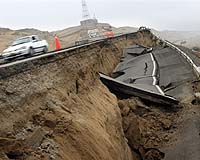| . |  |
. |
Southampton, UK (SPX) Jun 07, 2010 Geological investigations in the Himalayas have revealed evidence that when India and Asia collided some 90 million years ago, the continental crust of the Indian tectonic plate was forced down under the Asian plate, sinking down into the Earth's mantle to a depth of at least 200 km kilometres1. "The subduction of continental crust to this depth has never been reported in the Himalayas and is also extremely rare in the rest of world," said Dr Anju Pandey of the National Oceanography Centre in Southampton, who led the research. Pandey and her colleagues used sophisticated analytical techniques to demonstrate the occurrence of relict majorite, a variety of mineral garnet, in rocks collected from the Himalayas. Majorite is stable only under ultra-high pressure conditions, meaning that they must have been formed very deep down in the Earth's crust, before the subducted material was exhumed millions of years later. "Our findings are significant because researchers have disagreed about the depth of subduction of the Indian plate beneath Asia," said Pandey. In fact, the previous depth estimates conflicted with estimates based on computer models. The new results suggest that the leading edge of the Indian plate sank to a depth around double that of previous estimates. "Our results are backed up by computer modelling and will radically improve our understanding of the subduction of the Indian continental crust beneath the Himalayas," said Pandey. The new discovery is also set to modify several fundamental parameters of Himalayan tectonics, such as the rate of Himalayan uplift, angle, and subduction of the Indian plate. The study was supported by the UK's Natural Environment research Council. The researchers are Anju Pandey and Andy Milton of the National Oceanography Centre, Southampton, Mary Leech of San Francisco State university), and Preeti Singh and Pramod Verma of the University of Delhi. 1 Pandey, A, Leech, M., Milton, A., Singh, P. and Verma, P. K. Evidence of former majoritic garnet in Himalayan eclogite points to 200-km-deep subduction of Indian continental crust. Geology 38, 399-402 (2010). doi: 10.1130/G30584.1
Share This Article With Planet Earth
Related Links National Oceanography Centre, Southampton (UK) Tectonic Science and News
 Peruvian Tectonic Plates Move By Earthquakes And Non-Seismic Slip
Peruvian Tectonic Plates Move By Earthquakes And Non-Seismic SlipLivermore CA (SPX) May 11, 2010 Just a few years ago, Dan Farber happened to be doing field work in Peru with students when the 8.0 Pisco earthquake struck. As a scientist working in the active tectonics of the Peruvian Andes - funded through the Lawrence Livermore National Laboratory's Institute for Geophysics and Planetary Physics - Farber was asked by colleagues if he could participate in a rapid response team to map the da ... read more |
|
| The content herein, unless otherwise known to be public domain, are Copyright 1995-2010 - SpaceDaily. AFP and UPI Wire Stories are copyright Agence France-Presse and United Press International. ESA Portal Reports are copyright European Space Agency. All NASA sourced material is public domain. Additional copyrights may apply in whole or part to other bona fide parties. Advertising does not imply endorsement,agreement or approval of any opinions, statements or information provided by SpaceDaily on any Web page published or hosted by SpaceDaily. Privacy Statement |